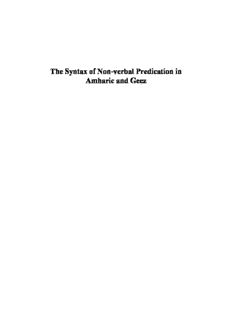Table Of ContentThe Syntax of Non-verbal Predication in
Amharic and Geez
Published by
LOT phone: +31 30 253 6111
Trans 10
3512 JK Utrecht e-mail: [email protected]
The Netherlands http://www.lotschool.nl
Cover illustration: The Dome Tower and its surrounding, Utrecht by Mulusew
Asratie
ISBN: 978-94-6093-154-3
NUR 616
Copyright © 2014: Mulusew Asratie Wondem. All rights reserved.
The Syntax of Non-verbal Predication
in Amharic and Geez
De syntaxis van Non-verbale predicatie
in het Amhaars en Geez
(met een samenvatting in het Nederlands)
proefschrift
ter verkrijging van de graad van doctor
aan de Universiteit Utrecht
op gezag van de rector magnificus, prof. dr. G.J. van der
Zwaan, ingevolge het besluit van het college voor promoties
in het openbaar te verdedigen op woensdag 19 november 2014
des ochtends te 10.30 uur
door
Mulusew Asratie Wondem
geboren op 7 januari 1972
te Felegebirhan, Ethiopië
Promotoren: Prof.dr. M.B.H. Everaert
Prof.dr. O.M. Matushansky
CONTENTS
List of Tables …….……………………………………………………...….i
Acknowledgement…………………………………….................................iii
Glosses Abbreviations……………………………........……………….….vii
PART ONE…………….........…………………………………………..……1
CHAPTER ONE: INTRODUCTION…………...………………………………3
1.Introduction………………………………………………………….3
2.The problem………………………………………………………….4
3.The data…………………………………………………………….10
4.Theoretical framework and review of related literature ............................ 12
4.1.The minimalist program in brief ………………………………….12
4.2.The structure of copular clauses………………………………… 13
4.2.1.Absence of a copula…….. ............................................................... 14
4.2.2.More than one copula ...................................................................... 20
4.2.3.Case-marking………… ................................................................... 23
5.Summary……………………. ................................................................... 29
CHAPTER TWO: THE MORPHOSYNTAX OF AGREEMENT, ASPECT AND TENSE IN
AMHARIC AND GEEZ………………………………………………………..31
1.Introduction……………………................................................................ 31
2.Aspect…………………………. ............................................................... 32
2.1.Perfective and imperfective verbs……………………………………32
2.1.1.Interpretation in embedded clauses……….................................... 33
2.1.2.Stative verbs…………................................................................... 35
2.1.3.The syntactic derivation of perfective and imperfective clauses...37
3.Agreement…………………….................................................................. 41
3.1.Subject agreement…….. .................................................................... 42
3.2.Object agreement……… ...................................................................... 43
3.2.1.Object agreement as a realization of affectedness .......................... 48
3.2.1.1.Semantic effects of object agreement ....................................... 48
3.2.1.2.Obligatory occurrence of object agreement .............................. 49
3.2.1.3.Impossibility of object agreement ............................................ 51
3.2.2.The syntax of affectedness.............................................................. 55
3.3.Genitive agreement……… ................................................................... 57
3.4.The phi-features of agreement .............................................................. 58
3.4.1.Morphological analysis of Geez independent pronouns:
The syntax of Non-verbal Predication in Amharic and Geez
thespeaker/ non-speaker and the proximate/distal distinction...…60
3.4.2.Proximity markers ......................................................................... 63
3.4.3.Gender and number marking ......................................................... 64
3.4.4.Reanalyzing the agreement system ................................................ 68
4.Summary………………………………. ................................................... 70
PART TWO……………………………. ........................................................ 71
CHAPTER THREE: NON-VERBAL PREDICATION IN AMHARIC……….………73
1.Introduction…………….………………… ............................................... 73
2.The role of copular verbs in Amharic ........................................................ 77
3.Amharic copulas as personal and impersonal verbs .................................. 79
4.Amharic copulas as raising verbs .............................................................. 84
4.1.Raising in Amharic…….. ...................................................................... 85
4.1.1.Subject raising ................................................................................. 86
4.1.2.Possessor Raising ............................................................................ 94
4.2.Copulas as raising verbs……… ......................................................... 100
5.Predicate selection………….…..……..………….. ................................ 104
6.Summary…………………………… ...................................................... 105
CHAPTER FOUR: CASE-MARKING IN AMHARIC NON-VERBAL PREDICATION 107
1.Introduction………..……………… .................................................... …107
2.Nominative predicates…………… ......................................................... 114
3.Accusative predicates………………. ..................................................... 119
4.How is nominative assigned to predicates? ............................................. 127
5.Summary…………………………… ...................................................... 130
PART THREE…………………..................................................................... 131
CHAPTER FIVE: NON-VERBAL PREDICATION IN GEEZ…….…………….133
1.Introduction…………………….............................................................. 133
2.Copulaless clauses………………. .......................................................... 137
3.Copular verbs…………………. .............................................................. 143
3.1.The role of copular verbs ................................................................... 145
3.2.The copula konä……………. ............................................................ 148
3.2.1.Subject raising in Geez ................................................................ 148
3.2.2.Predicate case-marking in subject-raising constructions ............. 151
3.2.3.Konä as a subject raising verb ...................................................... 153
3.3.The copula halläwä ………………………………………….155
3.3.1.Two types of Datives in Geez ....................................................... 156
3.3.2.Further properties of the case-marker lä-... .................................. 162
The syntax of Non-verbal Predication in Amharic and Geez
3.3.3.Interpretation……………….………. .............. ….………………166
3.3.4. Affected datives: control structures or structural dative cases...169
3.3.5.Halläwä as a possessor raising verb .............................................. 176
3.3.6.Accusative location ........................................................................ 177
3.3.6.1.Applicatives in Geez ................................................................ 177
3.3.6.2.The location PP as a high applicative ...................................... 184
4.Summary……….……………… ............................................................. 184
CHAPTER SIX: PRONOMINAL AND PREPOSITIONAL COPULAS ...................... 185
1. Introduction…………………................................................................. 185
2. Pronominal copulas………….. .............................................................. 188
2.1.The atemporal interpretation of pronominal copulas…….. ...... ……..190
2.2.Obligatory vs. optional presence and absence of pronominal
copulas..………………………...……………………………..… 191
2.3.Interpretational difference between pronominal copular clauses
and simple juxtaposed clauses………………………..………… 192
2.4.Syntactic structure of pronominal copula clauses ............................ 193
3. Prepositional copulas………… .............................................................. 195
4. Summary………………………. ....................................... …………….199
CHAPTER SEVEN: CONCLUDING REMARKS…… .......................................... 201
1.Introduction………………….................................................................. 201
2.Summary of the major claims .................................................................. 201
2.1. Chapter one…………..… .................................................................. 202
2.2. Chapter two………………..……………………………….….203
2.3. Chapter three……………... .............................................................. 203
2.4. Chapter four…………… .................................................................. 205
2.5. Chapter five…………… .................................................................. 205
2.6. Chapter six………..……. ................................................................. 206
3.Some theoretical implications ................................................................. 206
3.1. Syntactic structure of copular clauses ............................................... 207
3.2. On the relationship between BE and HAVE ................................... 209
3.2.1.Have = be + P(reposition)…………… .............................. 209
3.2.2.HAVE = BE + external argument ...................................... 211
3.2.3.The relation between BE and HAVE in Amharic and
Geez………...………………….…………….………212
4.Summary………………….. .................................................................... 213
References…………………………..…………………………………….…..215
The syntax of Non-verbal Predication in Amharic and Geez
Appendix………………………………..………………………….…………233
Samenvatting in het Nederlands………………………………………..……..243
Curriculum vitae………………………………………………………………245
LIST OF TABLES
Table 1: Reclassification of Geez pronouns………………………………………..67
Table 2: The copular and case-marking system of Amharic
non-verbal predication…………………………………………………......76
Table 3: Summary of agreement system of personal and
impersonal verbs…………………………………………………………….81
Table 4: The copular and case-marking system of Geez
non-verbal predication......................................................................136
ii The syntax of Non-verbal Predication in Amharic and Geez
Description:The syntax of Non-verbal Predication in Amharic and Geez .. titles and subtitles of the dissertation are enriched by your comments and suggestions. Our frequent .. agree, the unintepretable phi-features of the head are erased or deleted. If not, the inserting an expletive rather than movement. 4.2

